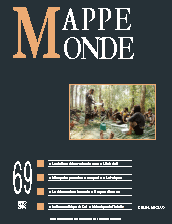

«The map of our land»: Implications of maps as seen by the Kayapó Indians (Amazon region of Brazil) (4 fig.)
A series of maps was made with the Kayapó Indians with a view to showing how the indigenous land was surrounded by grazing land and to spatialise naturalist knowledge about the land around one village. When the Kayapó realised the power of these documents, they expressed their interest instead in the construction of maps representing the whole indigenous territory. These maps highlight the territorial and social unity that the Kayapó wish to emphasise and are thus a particularly useful instrument in negotiations with non-Indians.
keyword: BRAZILIAN AMAZON, KAYAPÓ INDIGENOUS LAND, POWER OF MAPS, SPATIOMAP
Chorotype of the South Asian port metropolis (1 fig.)
The port metropolises of South Asia are major nodes at the head of the urban networks in the different countries of this region. Although these cities have particularities derived from their history, location, economy and demography, they also share common characteristics. During the colonial period, industrial and port functions were a major driver of urbanisation and continue to play a role in urban planning today. This paper proposes a graphic model of these trading posts, which became port metropolises, taking into account both spatial and temporal dimensions.
keyword: COLONIAL LEGACY, CHOROTYPE, PORT METROPOLISES, SOUTH ASIA
François Durand-Dastès. Model of trading posts. Trading posts in their environment (2 fig.)
Caroline Merle, Denis Gautier. Modelling fuel wood felling in the villages of southern Maroua (Cameroon) (8 fig.)
In the Far-North province of Cameroon, a spatial analysis of the factors in the location of fuel wood felling shows why felling is concentrated in certain sectors of the village land. The use of choremes highlights the influence of environmental and agronomic determinants, land control and the organisation of wood transport. The model of future felling contradicts the common belief that felling is anarchical, and marks a first step towards management of the regions timber resources.
keyword: FUEL WOOD FELLING, LOCATION FACTORS, NORTHERN CAMEROON
Wealth and population in the world: a multi-scale representation of inequality (4 fig.)
The unequal distribution of the world population and global wealth is usually analysed within the framework of countries. This paper proposes a different reading of global inequality, based on a multi-scale study of local differentials of spatial concentration of the population and global wealth. Although the hypotheses are simplistic (use of Euclidian distance), the proposed model nevertheless illustrates rather well the force fields and gradients that control the main migratory and economic flows in the world.
keyword: ACCESSIBILITY, INEQUALITY, MODELLING, MULTI-SCALE ANALYSIS, POPULATION, POTENTIAL, WEALTH, WORLD
Diaspora and the international economy: the case of South Africans of Indian origin (5 fig.)
The Government of India dreams that the Indian diaspora spread over the world plays an economic role similar to the one by the Chinese diaspora in China. While comparing three maps showing the location of overseas Indians and international investments, however, we realise that the countries with a large Indian community are not always major economic partners. True, India is still an important cultural reference for the diaspora, even when migration is very old. But in South Africa, most of the material links relating overseas Indians to the region of ancestral origin have been dissolved, all the more so since the break made by apartheid.
keyword: DIASPORA, FOREIGN DIRECT INVESTMENTS, INDIA, SOUTH AFRICA
Teaching geography. Changing scales: the beginnings of a necessary practice (2 fig.)
During observation and study of a geographical object, constant changes of scale are of utmost importance. Teachers of geography agree on this. This practice has a long history, dating back to the 18th century. Its educational aims, however, have not always been the same.
keyword: 18TH CENTURY, CHANGES OF SCALE, GEOGRAPHY, TEACHING
Enali de Biaggi, Martine Droulers. The island of Brazil: the power of a cartographic myth (3 fig.)
Numerous European maps from the 16th and 17th centuries show Brazil as an island. This representation unquestionably played a part in the formation of the largest country in Latin America.
keyword: BORDER, GEOGRAPHICAL MYTH, GEOHISTORY, NATION
Book reviews (Roget Brunet, Gilles Fumey, Cécile Gaudin)
Mappemonde 4/02![]()
![]() Mappemonde 2/03
Mappemonde 2/03
For subscribe or buy this issue: BELIN
Last modified: March 5, 2003